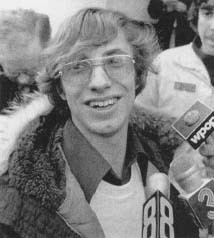Peter A. Reilly Trial: 1974 & 1976
New Evidence Results In Reversal
Community supporters remained convinced that Reilly was innocent, and that his original confession was the result of an impressionable and inexperienced young man led by suggestive police questioning to falsely incriminate himself. A later review of the lengthy transcripts of his interrogation supported this interpretation. Joan Barthel, a journalist who helped bring statewide and national attention to Reilly's cause, included much of the transcript in a book detailing the case.
The support group continued to widen, and the broadcast of a documentary on CBS television brought even more support. An appeal was mounted on three grounds: two citing new evidence, and one contending that the state failed to provide exculpatory material, records, and evidence at the original trial. The full transcript of the interrogation was part of that material. Attorneys for Reilly in the appeal were T.F. Gilroy Daly, Robert M. Hartwell, and John Fiore.
 A smiling Peter Reilly after charges against him were dismissed.
A smiling Peter Reilly after charges against him were dismissed.
Judge Speziale heard the appeal and rejected the claim that the state had failed to provide exculpatory material at the original trial. But Speziale accepted that the new evidence justified overturning the original verdict. The crucial new evidence consisted of a fingerprint that pointed suspicion at two other individuals, Timothy and Michael Parmalee. At the original trial, Sandra Ashner had claimed that Michael Parmalee was with her on the night of the murder, but in April of 1975 she said she had originally lied, and that Parmalee was not with her. Furthermore, the first person that Peter Reilly called on the night of the murder, Marion Madow, stated that he had called her during a certain moment of the television broadcast of the movie, Kelley's Heroes. CBS television was able to determine that that portion of the movie aired at precisely 9:50 P.M. This helped establish the time sequence, raising serious doubts whether Peter Reilly would have had time to commit the crime before calling for help. Since he had dropped off Sochocki at 9:45, and it took five minutes to drive to his home, it seemed evident that he made his first call for help immediately upon arriving home, leaving no time for him to have committed the crime.
Expert testimony from Dr. Herbert Spiegel suggested how Peter Reilly could have been led to confess, due to his difficulty of "integrating a concept of self." Reilly had been unable to distinguish between a statement and an assertion or a question, and could easily be led to accept as a fact something he knew nothing about.
Judge Speziale ruled that the new expert testimony, the fingerprint evidence, and the newly established evidence regarding timing were all sufficient to suggest that an injustice had been done in the original trial. He also ruled that none of that evidence could have been obtained by the defense counsel through due diligence in the first case. Since all three new pieces of evidence would establish a reasonable doubt as to Reilly's guilt, on March 25, 1976, he therefore ordered the release of Reilly pending a new trial. The state of Connecticut never attempted to bring another prosecution and Reilly remained free.
In later years, Reilly became active in popular efforts to question police interrogation methods.
—Rodney Carlisle
Suggestions for Further Reading
Barthel, Joan. A Death in Canaan. New York: E.P. Dutton, 1976.
Additional topics
Law Library - American Law and Legal InformationNotable Trials and Court Cases - 1973 to 1980Peter A. Reilly Trial: 1974 1976 - A Son Confesses, Jury Opts For Manslaughter, New Evidence Results In Reversal